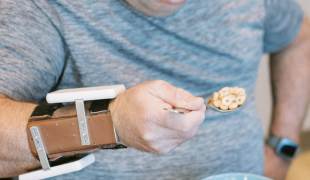- 5818
- 332
- 26
- 14
- 0
- Help Ukraine
About the solution
Project Emma is a wearable technology developed by Microsoft Research in collaboration with a graphic designer named Emma Lawton. Emma was diagnosed with Parkinson's disease at the age of 29 and had to give up her job as a graphic designer due to the tremors caused by the disease. Emma Lawton served as both the inspiration for the project and an advisor throughout its development.
The project aims to use technology to help people with Parkinson's disease regain control of their hand movements. The wearable device consists of a watch that vibrates at a certain frequency, which helps to counteract the tremors and stabilize the user's hand movements. The device is equipped with vibrating motors that pulse on the wrist at a set rhythm, allowing the user to write freely. It requires a Windows tablet to run the software. The device uses artificial intelligence and machine learning to adapt to the user's specific tremor patterns and adjust the vibrations accordingly.
Emma’s watch was developed by a team of engineers, designers, and medical professionals who worked closely with Emma to ensure that the technology met the needs of people with Parkinson's disease. The project was named after her and aimed to help her regain control of her hand movements so she could draw again.
The device has since been tested by other Parkinson's patients and has shown promising results in helping them improve their hand movements and perform everyday tasks more easily. The success of Project Emma has led to the development of other wearable technologies that aim to help people with Parkinson's disease and other neurological disorders.
Emma’s watch was first unveiled in 2017 at the Microsoft Build Developer Conference. The initial prototype of Project Emma was developed over the course of several months, and subsequent versions of the device were developed based on feedback from Emma Lawton and other individuals with Parkinson's disease. The team conducted several studies to evaluate the effectiveness of the technology in helping people with Parkinson's disease to manage their tremors and regain control of their movements.
Since the initial unveiling, the technology has generated significant interest and attention from the medical and technology communities, and it has been featured in numerous news articles and publications. The ongoing development of Project Emma is a testament to the power of collaboration between patients, engineers, and medical professionals to create innovative solutions to real-world health challenges.
Adapted from:
https://inovasocial.com.br/tecnologias-sociais/o-project-emma-o-wearable...
https://www.microsoft.com/en-us/research/project/project-emma/
https://www.sbs.com.au/guide/article/2017/03/13/meet-aussie-inventor-who...
https://www.youtube.com/watch?v=R6rAlFYDffQ
This solution shall not include mention to the use of drugs, chemicals or biologicals (including food); invasive devices; offensive, commercial or inherently dangerous content. This solution was not medically validated. Proceed with caution! If you have any doubts, please consult with a health professional.
DISCLAIMER: This story was written by someone who is not the author of the solution, therefore please be advised that, although it was written with the utmost respect for the innovation and the innovator, there can be some incorrect statements. If you find any errors please contact the patient Innovation team via info@patient-innovation.com
-
-
568
-
4
-
9395

EvoWalk - Stimulation Device for Walking Rehab in Neurological Patients
WALKING: Walking
Multiple Sclerosis
Assistive Daily Life Device (to help ADL)
Body-Worn solutions (Clothing, accessories, shoes, sensors...)
AI algorithm
pain
Difficulty coordinating movements
Restoring mobility
Rehabilitating After Stroke
Managing Neurological Disorders
Maintaining Balance and Mobility
To improve Treatment/Therapy
Neurology
Physical Medicine and Rehabilitation
United States
-
-
-
337
-
0
-
4169

Collaborator Pierluigi Mantovani creates Evolution Devices - solutions that aim to transform Multiple Sclerosis Management
CAREGIVING
BODY BALANCE: Maintaining body balance
STANDING UP: Standing up from a seated position
WALKING: Walking
Multiple Sclerosis
Assistive Daily Life Device (to help ADL)
Walking Aid (wheelchair/walker/crutches)
App (Including when connected with wearable)
AI algorithm
Body-Worn solutions (Clothing, accessories, shoes, sensors...)
Restoring mobility
Regaining sensory function
Managing pain
Promoting self-management
Preserving Organ Function
Managing Neurological Disorders
Maintaining Balance and Mobility
To improve Treatment/Therapy
Preventing (Vaccination, Protection, Falls, Research/Mapping)
Raise awareness
Caregiving Support
General and Family Medicine
Internal Medicine
Medical Genetics
Neurology
Physical Medicine and Rehabilitation
United States
-
-
-
600
-
0
-
10820

Man invents tremor-suppression technology to help people with Parkinson’s disease
Writing (letters, songs, peoms)
(SELF)-CARE: EATING: Eating independently.
(SELF)-CARE: DRINKING: Drinking independently.
BODY BALANCE: Maintaining body balance
Parkinson's Disease
Treatment/Surgical device
Body-Worn solutions (Clothing, accessories, shoes, sensors...)
Gait abnormalities (e.g., walking difficulties, unsteady gait)
Tremors
Muscle cramps or spasms
Difficulty coordinating movements
Stiffness or rigidity (difficulty moving)
Muscle weakness
Trouble with fine motor skills (e.g., writing, buttoning clothes)
Cognitive impairment
Headaches
Restoring mobility
Managing Neurological Disorders
To improve Treatment/Therapy
Preventing (Vaccination, Protection, Falls, Research/Mapping)
Neurology
Viet Nam
-
 en
en